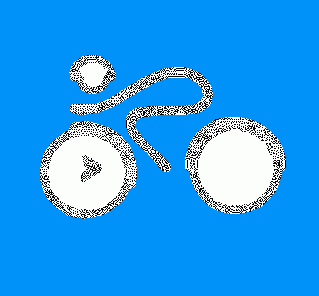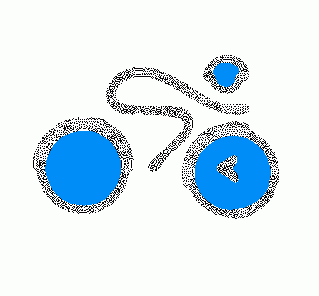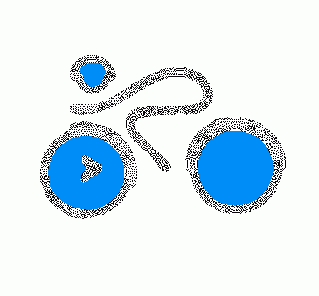| Newsletter - 2002 Archive |

|

|
Cycling Club |

|

|
| Newsletter - 2002 Archive |

|

|
Cycling Club |

|

|
Next--->
It is generally accepted that “Audax” (as in Audacious) Cycling originated in Italy in 1897. Participants had to swim, run, walk or cycle a set distance in 14 hours or approximately from sunup to sundown. For cyclists the distance was set at 200 km (125 miles). 14 hours remained the time limit for a 200 km randonnée until recent times when it was reduced to 13:30 to approximately align with the minimum event speed of 15 kph (i.e.; including ALL stops) of the current regulations.
Communication of the day was limited and the Italians were not to know that in 1891 on June 20th the first “York Run” was held in England. Organised by the North Road Cycling Club, the event required the participants to ride from the General Port Office in London, starting at midnight, to the GPO in York within 21 hours 30 minutes, a distance of 200 miles (320 km) north on the Great North Road. It is believed to be the first recorded occasion where an organised non-competitive ride of this nature took place. Post Offices were important for such endeavours as they possessed the only reliable clocks on display.
I quote from “Fifty Years of Road Riding” The book is the History of the North Road Cycling Club from its origin in 1885 to 1935:
The first York Run was held in 1891, and it gave rise to a remarkable amount of interest not only in the cycling world, but amongst the general public as well. Bennet Burleigh, a famous war correspondent for the Daily Telegraph, took a great and active interest in the event, and a long description of the event from his pen appeared in that paper. Burleigh rode a “full roadster” with the 25 starters as far a Grantham (about half way) where mechanical problems forced him onto a train so he could get to York and record the 10 survivors arrival in York.
The event continued every year until 1916 when the conditions created by World War 1 made it impractical to continue the ride. It was re-introduced in the late thirties as the beginning of the Easter Tour. That was ended in 1973 when the 3 riders were wiped out by a sleeping truck driver.
Later in 1891, in September, Parisien jounalist Pierre Giffard organised a ride that was intended to show that the bicycle was more than a toy to be ridden round the park and that it had serious travel capability. He chose to have the participants ride from Paris to Brest on the Northwest Coast of France and back again, a distance of about 1200 km (750 miles). (See separate PBP history)
In the 2002 handbook of Audax UK, a couple of pages are devoted to: “The Origins and History of AUK”. The first part is universal and I quote:
1904: Henri Desgranges (know as the father of the Tour de France) produced Audax regulations. These were the property of his magazine; Auto and formed cyclists into groups, each with a Captain, which stayed together for the entire 200km ride. Today this method is known as “Euraudax”. Cyclists who had gained the Brevet d’Audax formed the Audax Club Parisien (ACP) and organised events for Auto throughout France.
1920: ACP upset Desranges by assisting in an event sponsored by a rival newspaper. He withdrew the Club’s right to organise Audax events.
1921: ACP created the Brevets de Randonneurs to enable them to carry on their programme of events without infringing the Brevets d’Audax. These events differ from Euraudax in that cyclists do not have to ride as a group. Each individual can go at their own pace – “a allure libre” – and stop at will for refreshment.
To prevent racing, time checks were established at controls with minimum and maximum time limits. ACP has kept records of all Brevets de Randonnurs Francais (now Brevets de Randonneurs Mondiaux) from this date. It is the ACP regulations which were later adopted by Audax UK (and in fact, by all Audax- Randonneur groups around the world).
1976: Audax UK formed.
That year British Columbia’s late resident, ex-Brit John Hathaway (1924 – 1997), completed the Paris-Brest-Paris Audax ride during his Guinness Book of Records 50,000 cycling miles in a 100 weeks round the World Map. That includes all the time waiting for visas, or travelling in planes, boats or trains (including the Trans Siberian Railway). When, in October 1976, he returned to B.C. his stories of PBP Audax prompted 3 of his friends, Gerry Pareja, Wayne Phillips and Dan McGuire to consider riding the next PBP Randonnee.
1979: The 4 of them, Hathaway, Pareja, Phillips and McGuire, completed a 200, 300, 400, 600 km PBP qualifying series as well as a 1000 for good measure. They all were successful in France and thus became the pioneer BC Randonneurs.
About this time the International Randonneurs were being organised out of Syracuse, NY and a few years ago Randonneurs USA (RUSA) superceded that organisation.
PARIS-BREST-PARIS
1886: Britain’s
first long distance Bike Race, the North Road CC’s 24-hour
event produced a winning distance of 227miles under difficult
conditions. The winner, G.P. Mills, rode an ordinary (penny farthing/high
wheeler). The event continued on an annual basis (except for 2
World Wars) until 1999 when the first fatality and dreadful traffic
conditions caused the end of the event, at its 101st promotion.
(I put this in to counter that oft quoted mistake that PBP was
the oldest. It is since 1999, but up to then the NR 24 was the
oldest).
1891: In May 5 Englishmen went to France to ride the inaugural Bordeaux-Paris 600 km race:
· G.P. Mills, North Road; 1st in 26 hours 34 min 57 sec,
· Monty Holbein, North Road, 2nd @ 1 hour 14 min,
· T.A. Edge, North Road and J. Bates equal third @ 3 hours 37 min.
The Brits went to “Show the Frenchmen how to ride”. Apparently the locals learnt the lesson very well, it was about 70 years before another Brit had any success on French roads!
On September 6 207 cyclists left Paris to ride to Brest on the Northwest Coast of France and return to Paris, a distance of about 1200 km (750 miles). The originator, journalist Pierre Giffard, wished to demonstrate the bicycle as more than a toy to be ridden around the park. With no precedent by which to judge he set a time limit of 10 days. But the winner, Charles Terront, finished in 71 hours 22 minutes and 99 riders completed.
1901: The stress of riding such an event as PBP caused the organisers to set a 10-year interval. This second PBP race produced a winning time of 52:11. The winner, Maurice Garin, was to earn eternal fame 2 years later by winning the inaugural Tour de France. The field was split into 2 categories; “coureurs de vitesse” and “touristes routiers”, professional road racers and hard riding tourists
1903: After witnessing the success of 2 PBP races Henri Desranges planned a similar event that would travel round France. Thus PBP can be considered the progenitor of the Tour de France.
1911: 13 “CdV” and 120 “TR” riders started. Georget first back with a time of 50:13.
1921: 43 pros and 63 touristes started. Mottiat won with 55:07. Previous pro rider Ernest Paul was first tourist back with a time of 62 hours.
1931: Hubert Oppermann, the great Australian rider, completed by outwitting the Belgain and French riders in the sprint for the line on the velodrome and finished with a time of 49:23. TR riders Tranchart, Cottard and Ruard completed in 68:30.
1941: WW2
1948: A “Make Up” ride. Of eleven finishers Belgian Hendrickx won in 41:36:42
1951: 41 pros started, Diot set an all time record of 38:55 to win. First tourists back were Coutelier and Chetiveau. Four women completed on mixed tandems and Mlle Vassard became the first woman to complete PBP.
1956: A reduction of the interval from 10 to 5 years was decided upon. But the pro race was cancelled through lack of entries. Baumann was first back with 52:19.
1961: Pro race cancelled again. Fouace first back with 49:15
1966: Now a randonnée only. The first back, Belgian Herman de Munck: 44:21
1971: For the last time until centenary 1991, the Audax and randonnée events coincided. 330 audax riders and 328 randonneurs started. The audax started 4 days before the randonnee. Seven riders rode both! Hermann de Munck was first back again with 45:39. The first woman, Simone Astie, took 79:38.
1975: The gap for the Randonnee was now down to 4 years, while the Audax retained the 5-year interval. Last PBP run on main roads due to 2 fatalities. 714 starters. First back, de Munck, Cohen and Truchi in 43:27. The first women were Chantal de la Cruz and Nicole Chabriand inside 58 hours.
1979: A full Super Randonneur series became the qualification requirement. 1766 starters, 1573 finishers. First back Piguet and Baleydier inside 45 hours
1983: The 10th PBP randonnée. 2106 starters, 1903 finishers. First back; de Munck and Piguet inside 44 hours, American Susan Notorangelo (Mrs Lon Haldemann) set the women’s record at 54:40.
1987: 2597 starters and 2117 finished. First back; American Scott Dickson in 44hours. Brit woman, the late Fliss Beard, completed on trike inside 70 hours.
1991: The Centenary. 3281 started and about 2500 finished. Scott Dickson again first back with 43:42 and Nicole Chabriand first female back with 59:43.
1995: About 3000 starters. Tri-bars banned for safety reasons and mudguards become optional due to the inadequate design of bikes being sold. A group of 9 were the first finishers in 43:20 and the first woman back, Brigit Kerlouet, was within an hour of them with a time of 44:14.
1999: The ACP’s maximum entry was reached with 3573 from 28 countries of which 17% abandoned. First back, 2 Frenchmen in 44:22. First Woman; American Melinda Lyon inside 54 hours.
2003: Are you going?
_